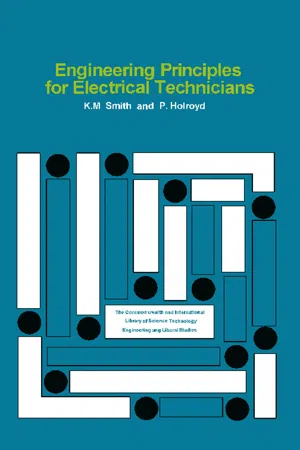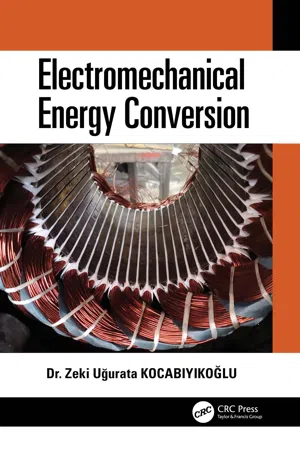Physics
Magnetic Flux and Magnetic Flux Linkage
Magnetic flux is a measure of the amount of magnetic field passing through a given area. It is represented by the symbol Φ and is defined as the product of the magnetic field strength and the area it passes through. Magnetic flux linkage is the total magnetic flux passing through a coil or circuit, taking into account the number of turns in the coil.
Written by Perlego with AI-assistance
Related key terms
Related key terms
1 of 4
Related key terms
1 of 3
6 Key excerpts on "Magnetic Flux and Magnetic Flux Linkage"
- eBook - ePub
- W. Bolton(Author)
- 2015(Publication Date)
- Routledge(Publisher)
Chapter 14 Magnetic flux14.1 Introduction
This chapter follows on from the discussion of magnetism in Chapter 10 and considers in more detail electromagnetic induction. Magnetic lines of force can be thought of as lines along which something flows, this being termed flux . When the magnetic flux linked by a coil changes then an e.m.f. is induced.We also look at the effect of the materials through which lines of magnetic flux pass. This is important since most devices employing magnetism involve the use of materials such as iron or steel in their construction. When any material is placed in a magnetic field, the extent to which the magnetic field permeates the medium when compared with what would happen in a vacuum is known as the relative permeability. For a material termed ferromagnetic, such as iron, there is a tendency for the lines of magnetic flux to crowd through it and it has a high relative permeability (Figure 14.1(a) ). An important consequence of this high permeability of iron is that an object surrounded by iron is almost completely screened from external magnetic fields as the magnetic flux lines crowd through the iron (Figure 14.1(b) ).Finally in this chapter we look at the forces experienced by current-carrying conductors when in magnetic fields, this being the basic principle behind d.c. motors.Figure 14.1 (a) A piece of iron in a magnetic field, (b) screening14.2 Electromagnetic induction
We can represent Faraday’s law and Lenz’s law for electromagnetic induction (see Chapter 10 ) as:induced e.m.f. e ∝ – (rate of change of flux Φ with time t )The minus sign indicates that the induced e.m.f. is in such a direction as to oppose the change producing it. We can put the constant of proportionality as 1 and write rate of change of flux as dΦ /dt :The unit of flux is the weber (Wb). If the flux linked changes by 1 Wb/s then the induced e.m.f. is 1 V. For a coil with N turns, each turn will produce an induced e.m.f. and so the total e.m.f. will be the sum of those due to each turn and thus: - eBook - ePub
Engineering Principles for Electrical Technicians
The Commonwealth and International Library: Electrical Engineering Division
- K. M. Smith, P. Holroyd, N. Hiller(Authors)
- 2013(Publication Date)
- Pergamon(Publisher)
Fig. 13.4(b) ) the voltmeter will indicate a deflection in the opposite direction to previously and the reversed current flow will make the left-hand end of the coil a south pole. The force set up tries to prevent the magnet from leaving the coil.It can be shown that the faster the magnet is moved, the bigger the deflection on the voltmeter, and for a given speed a stronger magnet will produce a bigger deflection than a weak one. In other words, a larger e.m.f. will be induced in the coil which in turn will cause a greater current.13.9 E.M.F. induced in a coil
During the movement of the magnet, the magnetic flux is said to be changing its linkage with the coil. Faraday’s law of induction states that the average e.m.f. induced in the coil depends upon the average rate of change of flux linkages.If N is the number of turns on the coil and Φ the flux linking the coil, N Φ is called the flux linkages. The average induced e.m.f. iswhere t is the time in seconds for the change of flux linkages and Φ is the flux in webers (pronounced “vayber”).13.10 Unit of magnetic flux
In the m.k.s. system of units, the weber (Wb) is the unit of flux. It is defined as follows: if a flux of 1 weber linking a coil of one turn were uniformly decreased to zero in one second, the e.m.f. induced in the coil would be 1 volt.andEXAMPLE A flux of 200 mWb, when linking a coil of 100 turns, is reduced uniformly to zero in 0·05 sec. What is the value of the e.m.f. induced in the coil during this period?13.11 Unit of magnetic flux density
Suppose that a magnetic flux were uniformly distributed over an area and that it was at right angles to this area. The density of the flux would be expressed as the amount of flux per unit area. In the m.k.s. system of units, the unit of area is the square metre and soIn the SI system the unit is the tesla (T).EXAMPLEIf a flux of 1 mWb is at right angles to an area of 20 cm2 , what is the flux density?13.12 Principle of the transformer
A simple transformer has two windings wound round a common magnetic core. If a current in one winding, called the primary, is continually changing its magnitude, there will be a continually changing magnetic flux. This flux will change its linkage with the other winding, called the secondary, and an e.m.f. will be induced in it. These conditions exist when the primary winding carries an alternating current. An alternating e.m.f. is induced in the secondary. - eBook - ePub
- Zeki Uğurata Kocabiyikoğlu(Author)
- 2020(Publication Date)
- CRC Press(Publisher)
Figure 2.1 ). In this book, we shall be using the following descriptions in the same meaning:Magnetic field = Magnetic flux =( Φ )(Measured in Webers)When the magnetic flux (Φ ) (or magnetic field) is distributed over an area A , the flux density at any point in that area is given asB =Φ AWb/m 2( T )In Figure 2.2a ,FIGURE 2.2 Magnetic flux lines around a current-carrying straight conductor (a) and a coil (b).- the flux density decreases outward from the conductor.
- for any point on the circles, the flux density (B ) is constant.
If a current-carrying wire is formed into a multiturn coil wound around an iron core of ferromagnetic material (Figure 2.2b ), the magnetic field is greatly intensified. The direction of the lines can be found with the help of a right-hand rule, which can be stated differently for each case:- “If the conductor in Figure 2.2a is grasped by the right hand (Figure 2.3a ), with the thumb pointing in the current direction, the flux direction will be in the direction of the fingers wrapping around the conductor”.
- Similarly, if the coil in Figure 2.2b is grasped in the right hand with the fingers pointing in the direction of the current (Figure 2.3b ), the thumb will point in the direction of the magnetic field. Notice that outside the core, field lines are from north (N) to south (S) pole, and inside the core, they are from south to north pole.
FIGURE 2.3 Right-hand rules for current-carrying conductor (a) and coil (b).2.3 Magnetic Fields of Electrons and Magnetic Moment
In both cases of permanent magnet and current-carrying conductor, the basic source of the magnetic field is the same. The cause of the magnetic field happens to be the current flowing or the “electrical charges in motion”. Electrons move around the nucleus like the Earth circles around the sun (Figure 2.4 - eBook - ePub
Calculations in Fundamental Physics
Electricity and Magnetism
- T. Heddle, Robert Robinson, N. Hiller(Authors)
- 2013(Publication Date)
- Pergamon(Publisher)
CHAPTER 10MAGNETIC FIELDS AND CIRCUITS
Publisher Summary
This chapter discusses the magnetic fields and circuits. In many magnetic circuits, having two or more parts in series, with different cross sections, and/or different materials, approximately the same flux passes through each section. Some leakage flux may bypass a section by a parallel path in air, just as electric current may leak through an insulator in parallel with the main circuit of conductors in series. The reluctance of each part of a series magnetic circuit can cause a magnetic potential drop (m.p.d.) along its length and require a part of the magnetomotive force (m.m.f.) to maintain the flux. For each part, the m.p.d. = flux × reluctance, just as electrical p.d. = current × resistance. The chapter also discusses numerical problems on suspended magnets. A suspended magnet behaves very much like a pivoted coil carrying current in a magnetic field. The continual spin of electrons in the atoms of the magnet provides the magnet with the equivalent of a current in a coil around it. Thus, the long, straight arrow may represent either a pointer along the axis of a coil, or a suspended bar magnet, turning into line with the flux.Straight Conductors
10.1 WORKED EXAMPLE
Two long parallel wires, 4.0 cm apart in air, carry currents of 5.0 A and 10.0 A respectively in the same direction. Calculate the resultant magnetizing force and flux density at a point 4.0 cm from each wire. Neglect other magnetic fields such as that of the Earth.Introduction
The resultant field is formed of two components, one due to each current.First, considering only one current, four important features of the magnetic field are detailed: (1) the flux density B , (2) the magnetomotive force (m.m.f.), (3) the magnetizing force H , and (4) the permeability μ.(1) Rearrangement of eqn. (1.6) gives B 1 = F 2 /l 2 I 2 . Hence the flux density B in teslas (T) or webers per metre2 (Wb m−2 ) may be defined by the force per unit length F /l in N m−1 exerted by the flux on a conductor carrying current I - No longer available |Learn more
- Robert A. Pelcovits, Joshua Farkas(Authors)
- 2023(Publication Date)
- Barrons Educational Services(Publisher)
15Electromagnetism
Learning Objectives
In this chapter, you will learn:Magnetic fluxFaraday’s lawInduced EMFLenz’s lawMotional EMFMaxwell’s EquationsCalculating The Magnetic Flux ΦBBefore we introduce Faraday’s law, we should discuss magnetic flux. You should already be familiar with the concept of flux and the mathematical definition of flux (phrased here in terms of magnetic flux).As before, dA, the differential area vector, is a vector pointing perpendicularly to a differential slab of surface area with magnitude equal to the differential area dA. In contrast to Gauss’s law, where we defined dA to point away from the center of the gaussian surface, we do not make a universal choice for the direction of dA when using Faraday’s law. However, we have to be consistent in the direction that we choose, as explained below.Flux Through a Single Loop
If the magnetic field is uniform in space (at any particular time), the equation for flux simplifies to If the magnetic field is not constant throughout the surface, we will need integration to calculate the magnetic flux. Here is a stepwise guide to carrying out the integration:1.Determine the geometry of the differential areas needed. The magnetic field must be uniform across each differential area so that it has constant flux density. Therefore, the shape of these differential regions must mirror the symmetry of the magnetic field.2.Determine the dimensions of the differential areas. You should arrive at an expression for dA in terms of various constants and one differential length (e.g., dx).3.Calculate the differential flux through a differential area according to the equation dΦB= B ⋅ dA. This involves arbitrarily setting dA to point in one of the two directions perpendicular to the area (recall that you must be consistent about this choice).4.To find the entire flux, integrate the expression for dΦBover limits determined by the geometry of the situation. Always integrate from the lower limit to the upper limit. Use the same choice for the direction of dA - eBook - ePub
Functional Molecular Materials
An Introductory Textbook
- Matteo Atzori, Flavia Artizzu(Authors)
- 2018(Publication Date)
- Jenny Stanford Publishing(Publisher)
This is one of the most ancient scientific subjects and one of the most difficult to understand. Closely connected with magnetism is magnetochemistry. This is a field of chemical physics that deals with magnetic measurements performed on chemical compounds, both molecular and atom based, as a tool to get information on their chemical structure. Finally molecular magnetism can be defined as a relatively new field of physics born to describe and understand the magnetic properties shown by magnetic molecular materials. 1 A deep knowledge of these three disciplines allows one to design new materials with expected magnetic properties and to understand their magnetic behaviors. The following sections describe their fundamental principles, with particular attention to those classes of materials that will be the theme of Chapter 3. 2.1.1 Magnetic Field One of the fundamental principles in magnetism is the concept of “magnetic field.” A magnetic field is produced whenever there is a charge in motion. This can be associated with an electrical current flowing in a conductor as was first discovered in 1819 by Oersted, or it can be generated by a permanent magnet. In the latter case there is no conventional electric current, but the orbital and spin motions of the electrons forming the permanent magnet lead to a magnetization within the material and to magnetic field generation. When a magnetic field is generated in a certain volume of space, an energy gradient is established and a force is produced
Index pages curate the most relevant extracts from our library of academic textbooks. They’ve been created using an in-house natural language model (NLM), each adding context and meaning to key research topics.
Explore more topic indexes
Explore more topic indexes
1 of 6
Explore more topic indexes
1 of 4





